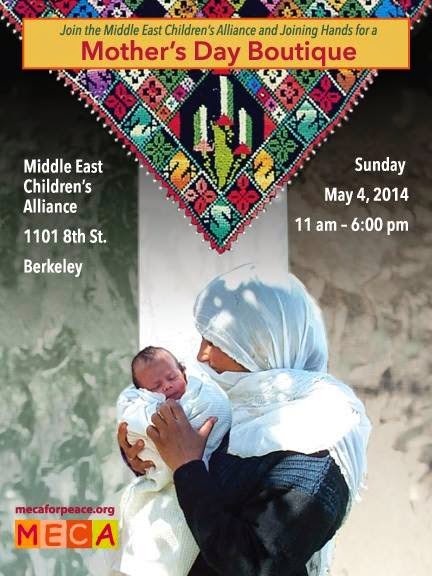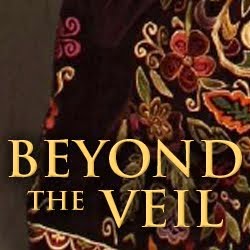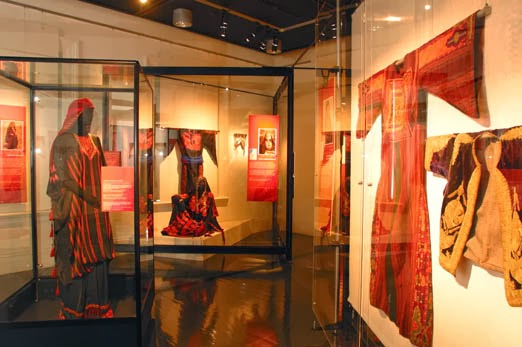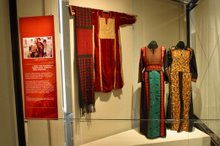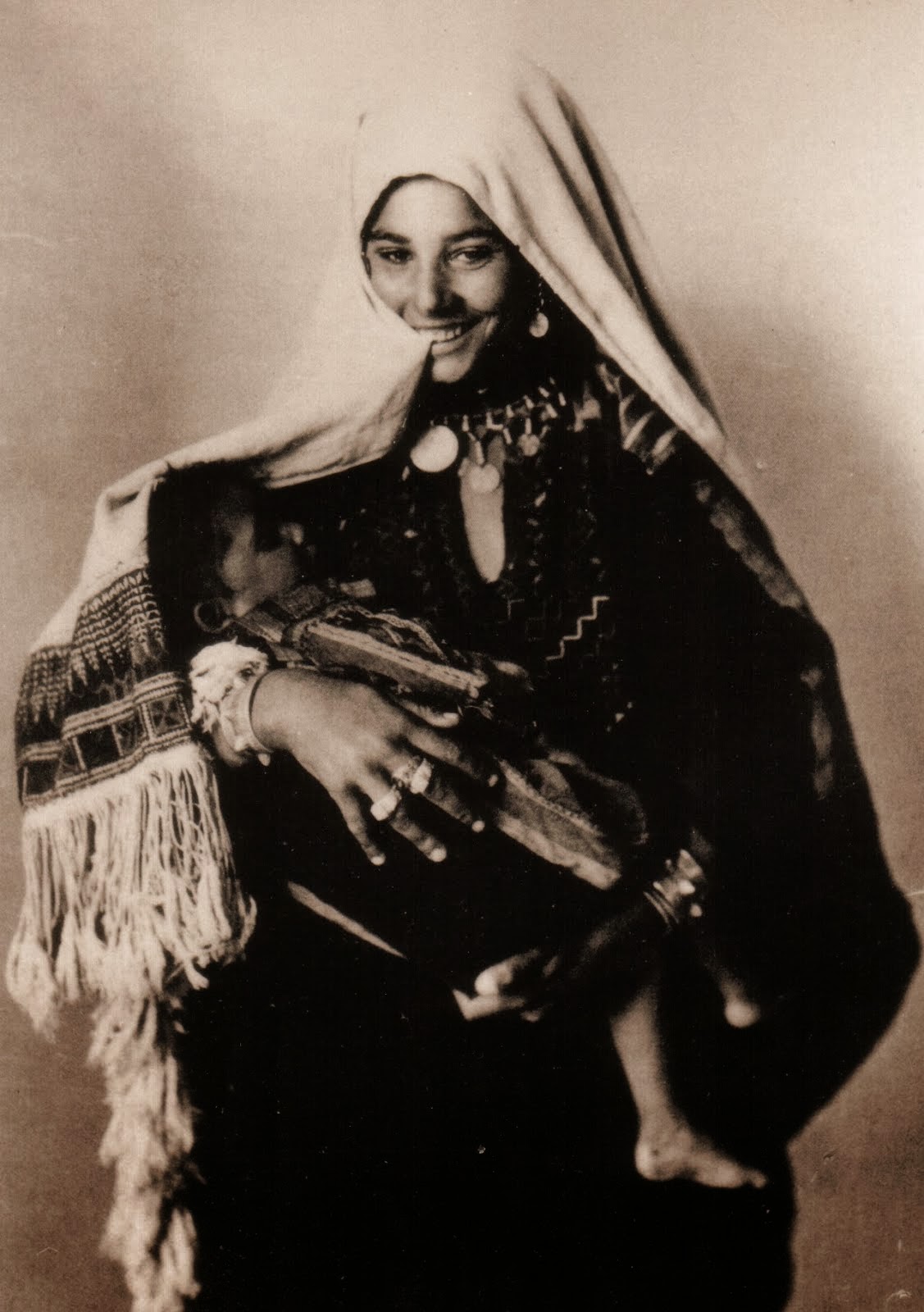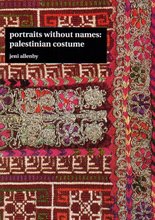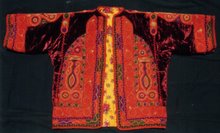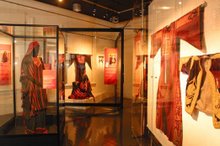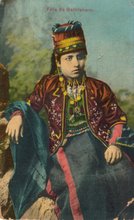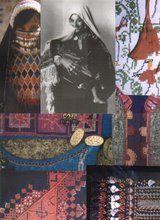 |
| meghamama Mural at al Am'ari Refugee Camp Photo courtesy: Flikr |
This post documents the discussion and research threads that resulted after Palestine Costume Archive staff discovered the photo above on Flikr. We are posting it so you can see all the interesting threads of Palestinian culture that come together, when we start discussing things here :)
The photo above is of a mural in al-Am'ari Refugee Camp. It was taken by meghamama on 17 March 2010 during a trip to Israel and the West Bank "digging up stories and sharing observations" while a student in "Annenberg's Religion, Politics and Gender reporting class". You'll find more info about the group on flikr. That's a whole different topic for another time!
Our first thread of discussion was to share what we knew of al-Am'ari. Wiki says of al Am'ari:
A second thread of discussion began when we realized we were familiar with al Ama'ari because it features in Yazan Khalili's "Colour Correction" series, which was recently displayed in the Australian Centre for Photography's Beyond the Last Sky exhibition:
We spent a long time looking at these works, as well as the rest of the exhibition. So we wanted to learn more about these works, and keep open the discussion about Palestinian contemporary art, as this was new to some of us.
So what are these works about? Well we have an idea but we think it's put best in this quote from the Edge of Arabia blog:
bright colours of Khalili's vision.
This brings us to another research / discussion thread - Palestinian graffiti. You'll find more photos of al Am'ari murals here, here and here (Al Monitor's photo essay on Palestinian street art). The photographer of the photo above, meghamama, has also taken other photos:
Our first thread of discussion was to share what we knew of al-Am'ari. Wiki says of al Am'ari:
"al-Am'ari Refugee Camp (Arabic: مخيّم الأمعري) is a Palestinian refugee camp in the Ramallah and al-Bireh Governorate, located 2 kilometers South of Ramallah in the central West Bank. According to the Palestinian Central Bureau of Statistics (PCBS), the Camp had a population of 5,719 inhabitants in mid-year 2006. The al-Am'ari camp has 10,377 registered refugees.
"The al-Am'ari camp was established in 1949 on 90 dunums within the municipal boundaries of al-Bireh. By 1957, all tents in the camp were replaced with cement block shelters. Like most of the West Bank camps, Amari suffers from overcrowding, poor sewerage and water networks. The camp falls in under Palestinian Authority control.
"The refugee camp has 2 schools, the boys school has 1250 pupils and the girls school has 970 pupils. The al-Am'ari camp's football team has won the Palestine football championship several times and has been designated to represent Palestine in regional and international competitions"You'll find more information on UNRWA's website. What interested us personally on that site was that the original camp provided "tents to refugees from the cities of Lydd, Jaffa and Ramla, as well as from the villages of Beit Dajan, Deir Tarif, Abu Shoush, Nanaa, Sadoun Janzeh and Beit Naballa".
A second thread of discussion began when we realized we were familiar with al Ama'ari because it features in Yazan Khalili's "Colour Correction" series, which was recently displayed in the Australian Centre for Photography's Beyond the Last Sky exhibition:
 | |
| Yazan Khalili "Colour Correction, Camp Series #3" 2007 Photo: courtesy Beyond the Last Sky exhibition website |
 | |
| Yazan Khalili "Colour Correction series" 2007-10 The Future of a Promise, Venice Biennale photo courtesy: here |
We spent a long time looking at these works, as well as the rest of the exhibition. So we wanted to learn more about these works, and keep open the discussion about Palestinian contemporary art, as this was new to some of us.
So what are these works about? Well we have an idea but we think it's put best in this quote from the Edge of Arabia blog:
"The Colour Correction Series explores the idea of losing lifestyle, mobility, freedom of choice and even the ability to dream of a brighter tomorrow. According to Slovenian philosopher Slavoj Žižek, these losses lead to a permanent state of emergency, where the possibility of thinking and living in the present becomes impossible.
"This specific image shows Al-Amari Refugee Camp, located inside/beside/outside Ramallah City. The form of the camp does not represent its economic status, but rather its loss and trauma as a political manifestation that persists due to the continuous emergence of ephemeral homes, contradictory ways of living and unbearably unstable relationships between Palestinians and their surrounding landscape. Altering the refugee camp’s colours is a symbolic act. It aims to fill the loss – in the way a child fills the blanks in colouring books – and thus reignite the possibility of hope. Here Yazan Khalili attempts to appropriate an urban landscape that reminds us of the tragedy – of their existence and our disappearance – in order to subvert memory into a desired future."We think the artist achieves this brilliantly. But we were also amused because when we first saw this series of images in Sydney we said to one another "we don't think the artist has altered al-Am'ari's colours. That's just what the graffiti / street artists have painted the refugee camp this week!". Because al-Am'ari's walls always seem to be covered with amazing commemorative art that echoes the
bright colours of Khalili's vision.
This brings us to another research / discussion thread - Palestinian graffiti. You'll find more photos of al Am'ari murals here, here and here (Al Monitor's photo essay on Palestinian street art). The photographer of the photo above, meghamama, has also taken other photos:
 |
| meghamama Mural at al Am'ari Refugee Camp Photo courtesy: Flikr |
The mural at the top appears in the work of another photographer that you can see here - this photo is taken from further back, which allows us to see this figure shares the wall with Handala. We love how this mural - all of them, really - portray so much Palestinian political iconography: the map / the key / the colours of the flag / barbed wire / tears of blood / the Arabic slogans etc. But for us, we know we are biased lol - it's all about the strength of this woman standing in her traditional dress holding her house key:
And not forgetting her smiling green eyes:
We also love this one for the magical multicoloured bird the young Palestinian boy is riding:
 |
| meghamama Mural at al Am'ari Refugee Camp Photo courtesy: Flikr |
The Archive has kept an eye on Palestinian street art for years - we've been collecting photos of it since the first intifada thirty years ago, a time when as Juliet Peteet noted in “The Writing on the Walls: the Graffiti of the Intifada" graffiti first assumed the role of “the silent narrative accompanying acts of resistance [and] … themselves acts of resistance”. It's a vibrant form of contemporary Palestinian culture and we were very worried no-one was documenting or preserving it. Luckily these days there's a lot more interest - just google "Palestinian graffiti" or "Palestinian street art" as well as a substantial body of academic publications.
We've also watched with interest as the wall has become a popular spot for international artists. You'll find lots of info about this online, both in regard to the artists creating it and outside organizations like Breaking the Silence Mural and Arts Project who traveled to the West Bank and Gaza to facilitate community art projects:
"Break the Silence Mural and Arts Project works in the intersection of trauma, memory, creativity, resilience and resistance, making visible the connections between struggles for social justice globally and histories that have been obliterated or forgotten. The project aims to engage the public on multiple levels to create potential spaces for critical thinking and action that advances progressive social change.
"BTS works across movements- using culture to create alliances as well as perceptual ‘ruptures’ or ‘disturbances’ wherein people have the opportunity to see connections that they had not seen before, and to imagine new possibilities. BTS works in partnership with a wide range of organizations, from mental health programs in Gaza, to environmental organizations, to organizations providing material aid, to those organizing non-violent resistance. Our ultimate goal is to use culture as an organizing tool to bring people together across movements. Our cultural products are then used by activists and organizers in their work to touch and move people."As one example of their current work see this report of their Sabra and Shatila commemorative mural project.
See how much we learned, researching Palestinian cultural heritage today :)
References plus more links that might be of interest:
- meghamama
- meghamama- photos tagged al Amari
- Wiki - al Amari
- UNRWA - al Am'ari
- Yazan Khalili - Venice Biennale 2011
- Edge of Arabia - Yazan Khalili
- ACP - Beyond the Last Sky exhibition - Yazan Khalili
- Handala
- Al Monitor - Palestinian street art
- Palestine Works - Addameer
- Julie Peteet (1996). “The Writing on the Walls: the Graffiti of the Intifada.” Cultural Anthropology 11(2): 139-159.
- Julie Peteet (2008) "Words as interventions: naming in the Palestine – Israel conflict" Third World Quarterly Volume 26, Issue 1, 2005 pages 153-172
- Breaking the Silence Mural and Arts Project
- Breaking the Silence - on Facebook
- Breaking the Silence - Report of Sabra and Shatila commemorative mural project.
- Sam Kestenbaum - "Stories on the Wall: Refugees in Ramallah" Tikkun Daily January 25th, 2012
Images:
Photos: courtesy: meghamama- photos tagged al Amari
Art works: courtesy ACP - Beyond the Last Sky exhibition - Yazan Khalili



